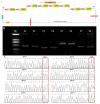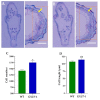Generation of High Yielding and Fragrant Rice (Oryza sativa L.) Lines by CRISPR/Cas9 Targeted Mutagenesis of Three Homoeologs of Cytochrome P450 Gene Family and OsBADH2 and Transcriptome and Proteome Profiling of Revealed Changes Triggered by Mutations
- PMID: 32586052
- PMCID: PMC7355857
- DOI: 10.3390/plants9060788
Generation of High Yielding and Fragrant Rice (Oryza sativa L.) Lines by CRISPR/Cas9 Targeted Mutagenesis of Three Homoeologs of Cytochrome P450 Gene Family and OsBADH2 and Transcriptome and Proteome Profiling of Revealed Changes Triggered by Mutations
Abstract
The significant increase in grain yield and quality are often antagonistic but a constant demand for breeders and consumers. Some genes related to cytochrome P450 family are known for rice organ growth but their role in controlling grain yield is still unknown. Here, we generated new rice mutants with high yield and improved aroma by simultaneously editing three cytochrome P450 homoeologs (Os03g0603100, Os03g0568400, and GL3.2) and OsBADH2 with the CRISPR/Cas9 system, and RNA-sequencing and proteomic analysis were performed to unveil the subsequent changes. High mutation efficiency was achieved in both target sites of each gene and the mutations were predominantly only deletions, while insertions were rare, and no mutations were detected in the five most likely off-target sites against each sgRNA. Mutants exhibited increased grain size, 2-acetyl-1-pyrroline (2AP) content, and grain cell numbers while there was no change in other agronomic traits. Transgene-DNA-free mutant lines appeared with a frequency of 44.44% and homozygous mutations were stably transmitted, and bi-allelic and heterozygous mutations followed Mendelian inheritance, while the inheritance of chimeric mutations was unpredictable. Deep RNA sequencing and proteomic results revealed the regulation of genes and proteins related to cytochrome P450 family, grain size and development, and cell cycle. The KEGG and hub-gene and protein network analysis showed that the gene and proteins related to ribosomal and photosynthesis pathways were mainly enriched, respectively. Our findings provide a broad and detailed basis to understand the role of CRISPR/Cas9 in rice yield and quality improvement.
Keywords: CRISPR/Cas9; cytochrome P450; mutations; proteome; rice; transcriptome; yield.
Conflict of interest statement
The authors declare no conflict of interest.
Figures





Similar articles
-
CRISPR/Cas9 Guided Mutagenesis of Grain Size 3 Confers Increased Rice (Oryza sativa L.) Grain Length by Regulating Cysteine Proteinase Inhibitor and Ubiquitin-Related Proteins.Int J Mol Sci. 2021 Mar 22;22(6):3225. doi: 10.3390/ijms22063225. Int J Mol Sci. 2021. PMID: 33810044 Free PMC article.
-
Programmed Editing of Rice (Oryza sativa L.) OsSPL16 Gene Using CRISPR/Cas9 Improves Grain Yield by Modulating the Expression of Pyruvate Enzymes and Cell Cycle Proteins.Int J Mol Sci. 2020 Dec 29;22(1):249. doi: 10.3390/ijms22010249. Int J Mol Sci. 2020. PMID: 33383688 Free PMC article.
-
Creation of novel alleles of fragrance gene OsBADH2 in rice through CRISPR/Cas9 mediated gene editing.PLoS One. 2020 Aug 12;15(8):e0237018. doi: 10.1371/journal.pone.0237018. eCollection 2020. PLoS One. 2020. PMID: 32785241 Free PMC article.
-
Unleashing the Potential of CRISPR/Cas9 Genome Editing for Yield-Related Traits in Rice.Plants (Basel). 2024 Oct 24;13(21):2972. doi: 10.3390/plants13212972. Plants (Basel). 2024. PMID: 39519891 Free PMC article. Review.
-
Biosynthesis of 2-Acetyl-1-pyrroline in Fragrant Rice: Recent Insights into Agro-management, Environmental Factors, and Functional Genomics.J Agric Food Chem. 2023 Mar 15;71(10):4201-4215. doi: 10.1021/acs.jafc.2c07934. Epub 2023 Mar 7. J Agric Food Chem. 2023. PMID: 36880506 Review.
Cited by
-
CRISPR/Cas9 Guided Mutagenesis of Grain Size 3 Confers Increased Rice (Oryza sativa L.) Grain Length by Regulating Cysteine Proteinase Inhibitor and Ubiquitin-Related Proteins.Int J Mol Sci. 2021 Mar 22;22(6):3225. doi: 10.3390/ijms22063225. Int J Mol Sci. 2021. PMID: 33810044 Free PMC article.
-
The transcription factor OsNAC25 regulates potassium homeostasis in rice.Plant Biotechnol J. 2025 Mar;23(3):930-945. doi: 10.1111/pbi.14550. Epub 2024 Dec 18. Plant Biotechnol J. 2025. PMID: 39693105 Free PMC article.
-
CRISPR/Cas9-Mediated Editing of AGAMOUS-like Genes Results in a Late-Bolting Phenotype in Chinese Cabbage (Brassica rapa ssp. pekinensis).Int J Mol Sci. 2022 Nov 30;23(23):15009. doi: 10.3390/ijms232315009. Int J Mol Sci. 2022. PMID: 36499334 Free PMC article.
-
Improvement of resistance to rice blast and bacterial leaf streak by CRISPR/Cas9-mediated mutagenesis of Pi21 and OsSULTR3;6 in rice (Oryza sativa L.).Front Plant Sci. 2023 Jul 17;14:1209384. doi: 10.3389/fpls.2023.1209384. eCollection 2023. Front Plant Sci. 2023. PMID: 37528980 Free PMC article.
-
Production of aromatic three-line hybrid rice using novel alleles of BADH2.Plant Biotechnol J. 2022 Jan;20(1):59-74. doi: 10.1111/pbi.13695. Epub 2021 Sep 12. Plant Biotechnol J. 2022. PMID: 34465003 Free PMC article.
References
-
- Taguchi-Shiobara F., Kawagoe Y., Kato H., Onodera H., Tagiri A., Hara N., Miyao A., Hirochika H., Kitano H., Yano M. A loss-of-function mutation of rice DENSE PANICLE 1 causes semi-dwarfness and slightly increased number of spikelets. Breed. Sci. 2011;61:17–25. doi: 10.1270/jsbbs.61.17. - DOI
Grants and funding
LinkOut - more resources
Full Text Sources
Other Literature Sources
Research Materials

